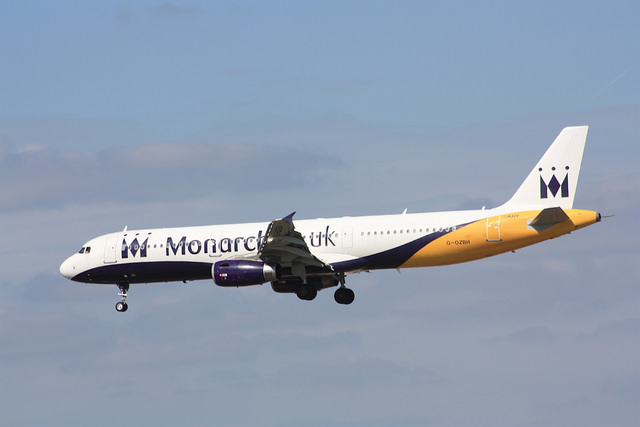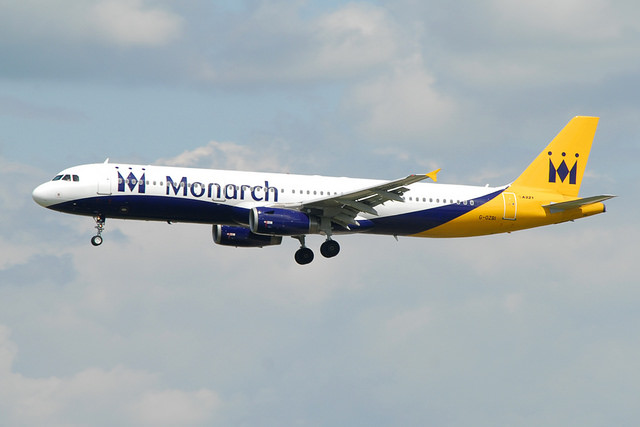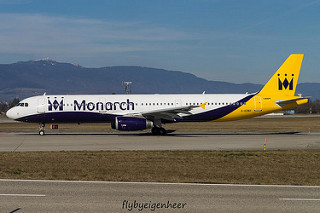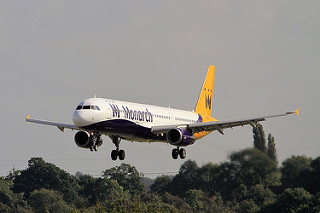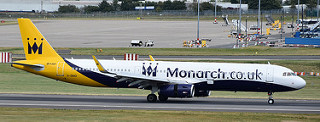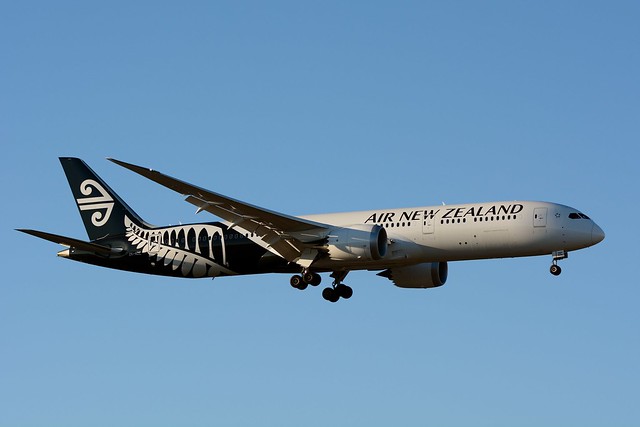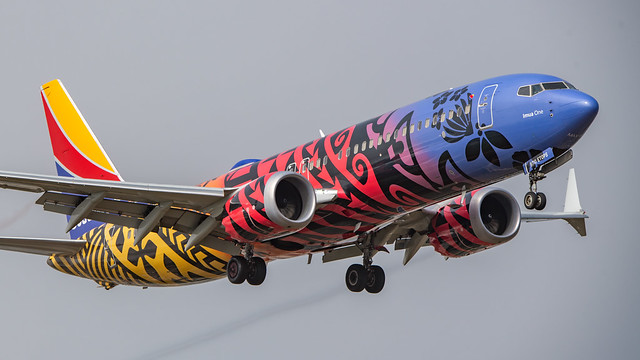Monarch A320 at Prestwick on Apr 10th 2013, rejected touch and go fails shock absorbers, autoflight and flight directors
Last Update: July 16, 2014 / 14:57:21 GMT/Zulu time
Incident Facts
Date of incident
Apr 10, 2013
Classification
Accident
Airline
Monarch Airlines
Departure
Birmingham, United Kingdom
Destination
Manchester, United Kingdom
Aircraft Registration
G-OZBY
Aircraft Type
Airbus A320
ICAO Type Designator
A320
The French BEA quoted the AAIB stating that there were no checklists found for the resulting situation after the last touch and go. The AAIB have opened an investigation into the occurrence that was rated an accident.
In July 2014 the British AAIB released their final bulletin without conclusions but reporting, that the aircraft carried two training captains, a safety pilot and 11 trainees. Each of the trainees was to fly 4 circuits, the instruction was to not use auto-brakes, no use of reverse thrust, the trainee would land the aircraft on the center line, take his hands off the thrust levers, the training captain would then disarm the spoilers, select flaps 2, check the stabilizer trim, apply TOGA, check the speeds and call rotate at Vapp.
One of the trainees was completing his final circuit with flaps selected to full, touchdown and initial roll out were normal. The training captain disarmed the spoilers, selected flaps 2, set the trim, selected Maximum Continuous Thrust, and after the flaps had reached their commanded position applied TOGA and called rotate. Shortly after a takeoff configuration alert sounded, the captain looked down and noticed a "SPD BRK NOT RETRACTED" ECAM message. The captain decided to reject takeoff, during rotation for takeoff he intervened at the controls, closed the thrust levers and made nose down inputs on the side stick. The AAIB reported the captain did not recollect whether he called stop. Dual inputs occurred from both the training captain and the trainee in the following seconds. The captain applied hard brakes until he was sure the aircraft would stop on the runway surface, then released some of the brakes pressure. After the aircraft had come to a stop on the runway the captain taxied the aircraft off the runway. The crew was aware that the nose gear had come down hard, but did not think it had been excessive.
While the aircraft taxied off the runway ATC queried whether any assistance was needed, the captain advised that no assistance was needed. The brakes fans were activated to aid cooling down the brakes and both training captains began to discuss why the configuration alert had occurred identifying the spoilers. No malfunction of the spoiler system was identified, the captains decided to continue the training but without arming the spoilers for the subsequent circuits.
The training captains also discussed the nose wheel touchdown amongst themselves and with the trainees, none of the crew believed the touch down constituted a hard landing, no inspection was needed.
The aircraft was prepared for the next circuit, the next trainee took the right hand seat, the crew attempted to enter a flight plan into the CDU which appeared to have remained in the go-around mode. The crew failed to enter a flight plan, attempted to use the secondary flight plan but also failed to enter the flight plan there. The captain eventually decided that a flight plan was not needed in the FMS as they were doing visual circuits only and briefed the trainee to not immediately retract the landing gear after positive climb had been established to assist cooling down the brakes.
The aircraft departed runway 13 using TOGA, after positive climb the captain reduced the thrust setting to MCT, then noticed a "L/G shock absorber fault" message on the ECAM, the captain advanced the thrust levers into the CL detent, climbing through 800 feet AGL the engines decelerated to idle thrust, the safety pilot noticed the thrust reduction and made the captain aware. The aircraft slowed and began to descend, when the training captain in the left hand seat took control of the aircraft, applied manual thrust and climbed the aircraft to circuit altitude. The trainee was replaced by the second training captain, who then assessed the status of the aircraft, the ECAM actions of the shock absorber fault were carried out requiring the landing gear remaining down and the airspeed limited to 280 KIAS. The training captains decided that the training should be aborted and decided to return to Birmingham,EN (UK). Enroute to Birmingham the crew consulted with dispatch and it was decided to divert to Manchester,EN (UK), where the aircraft landed safely.
The AAIB stated: "The commander reported afterwards that, following the RTO and despite the lack of automation, the aircraft handled normally and, in the conditions, he had not found it especially demanding to fly. However, he also commented that the workload had been increased by the lack of information about the status of the aircraft’s systems. He believed they had experienced a speedbrake fault and did not necessarily associate the shock absorber fault message with a hard landing. He could not understand why the autopilot and autothrust were not available and stated that the relevant information was not provided either by the ECAM or in the Flight Crew Operating Manual (FCOM)."
The AAIB reported that the weather at Prestwick at the time of the accident was reported as winds from 120 degrees at 6 knots, visibility 9000 meters, temperature +10 degrees C, dew point -2 degrees C, QNH 1003.
The AAIB reported that according to the flight data recorder both main wheels' weight on wheel sensors had already transitioned to airborne for one sample (sample rate 1 per second) when the takeoff was rejected. The weight on wheels sensors then showed weight again, the pitch decreased reaching a rate of 9.8 degrees/second and the nose gear touched down producing a recording of a vertical acceleration of +1.52G at the flight data recorder. The aircraft came to a stop with about 560 feet of runway remaining. Between touchdown and rejected takeoff the aircraft had reached a minimum of 131 knots and accelerated to 147 knots over ground again.
During the subsequent flight the nose wheel's weight on wheels sensor remained active even after becoming airborne disabling the use of the autopilot. When the speed levers were put into the CL detent the autothrust engaged in SPD mode, the commanded speed was 130 knots slower than the current speed causing the autothrust system to reduce engine thrust. The autothrust and flight directors were disengaged at 1200 feet AGL with the aircraft decelerating, the commanded speed was selected above current speed 5 seconds later, the thrust levers were advanced and the side stick inputs changed from right hand to left hand controls. Shortly afterwards the EGPWS activated due to altitude loss after takeoff. The aircraft then climbed to 1600 feet AGL, flew a couple of holding patterns before climbing to FL190 for the diversion to Manchester, the gear remained down during the entire flight.
The AAIB analysed: "The available evidence suggested that the configuration warning resulted from the speed brake lever being inadvertently placed in the speed brake range, during the touch-and-go landing, in such a position that it did not command spoiler surface deflection. The timing of this selection indicated that it occurred when the ground spoilers were being disarmed by the commander pressing the lever downwards. This then caused the takeoff config warning to be activated after takeoff power was set, and the commander rejected the takeoff."
The AAIB continued analysis: "The decision to reject a takeoff is normally a rule-based decision with clearly defined failure events and a calculated V1 decision speed. The manufacturer advises that a touch-and-go should not be rejected once toga is set, unless the commander is certain the aircraft will not safely fly, and notes that there is no V1 decision speed on a touch-and-go. The takeoff config warning is not activated until the thrust levers reach takeoff power. Therefore, during a touch-and-go the warning will always occur after mct or toga is set and at a higher speed than for a normal takeoff. On this occasion, after setting mct, the commander believed that the safety of the aircraft might be compromised if they continued, so he rejected the takeoff. During the RTO there was a period of dual inputs on the pilots’ sidestick controls, lasting for a few seconds. The absence of a STOP call probably contributed to this."
With respect to the hard landing the AAIB analysed: "No LOAD report was generated as none of the Normal ‘g’ or radio altimeter descent rate thresholds were exceeded during the RTO. The aircraft manufacturer stated that the LOAD algorithms are not capable of detecting all cases of abnormal landings and that the detection of this kind of occurrence is outside the scope of the LOAD report. The detection of possible nose landing gear damage remains the pilots’ assessment of the touchdown. On this occasion, the crew did not consider the touchdown on the nose landing gear to be excessive and there was no indication of damage or fault with the aircraft until the subsequent takeoff."
With respect to the safety pilot the AAIB analysed: "Each training captain was scheduled to carry out some 24 takeoffs and landings, assuming that no additional training was required. A safety pilot is required to be on board to monitor the safety of the aircraft during base training as an ‘extra pair of eyes’ in case of errors or distractions. Therefore, the safety pilot for this detail was responsible for monitoring the safety of at least, 48 takeoffs and landings. For a single crew member to remain alert throughout this whole period would be demanding. During the ground roll in a touch‑and‑go landing there are a number of actions for the safety pilot to monitor. From the jump seat position, though, it is unlikely that he would have been able to see clearly if the speedbrake lever was slightly out of its detent. During the subsequent takeoff he drew the commander’s attention to the unexpected behaviour of the thrust."
Incident Facts
Date of incident
Apr 10, 2013
Classification
Accident
Airline
Monarch Airlines
Departure
Birmingham, United Kingdom
Destination
Manchester, United Kingdom
Aircraft Registration
G-OZBY
Aircraft Type
Airbus A320
ICAO Type Designator
A320
This article is published under license from Avherald.com. © of text by Avherald.com.
Article source
You can read 2 more free articles without a subscription.
Subscribe now and continue reading without any limits!
Read unlimited articles and receive our daily update briefing. Gain better insights into what is happening in commercial aviation safety.
Send tip
Support AeroInside by sending a small tip amount.
Related articles
Monarch A321 at Menorca on Jul 21st 2017, undercut by a private plane on final ILS approach
A Monarch Airlines Airbus A321-200, registration G-OZBH performing flight ZB-942 from Birmingham,EN (UK) to Menorca,SP (Spain), had been cleared for…
Monarch A321 enroute on Aug 27th 2015, two small lavatory fires
A Monarch Airlines Airbus A321-200, registration G-OZBI performing flight ZB-472 from Birmingham,EN (UK) to Sharm el Sheikh (Egypt) with 194…
Monarch A321 at Birmingham on Mar 16th 2017, rejected takeoff due to engine fault
A Monarch Airbus A321-200, registration G-OZBU performing flight ZB-970 from Birmingham,EN (UK) to Malaga,SP (Spain), was accelerating for takeoff…
Monarch A321 at Funchal on Jan 23rd 2017, flaps problem
A Monarch Airlines Airbus A321-200, registration G-OZBR performing flight ZB-744 from London Gatwick,EN (UK) to Funchal (Portugal) with 137…
Monarch A321 near London on Sep 14th 2016, hydraulic issue
A Monarch Airlines Airbus A321-200, registration G-ZBAD performing flight ZB-492 from Birmingham,EN (UK) to Alicante,SP (Spain), was enroute at FL300…
Newest articles
ANZ B789 over Timor Sea on Apr 16th 2024, turbulence injures passenger
An ANZ Air New Zealand Boeing 787-9, registration ZK-NZC performing flight NZ-65 from Denpasar (Indonesia) to Auckland (New Zealand), had just…
Southwest B38M at Washington on Apr 18th 2024, runway incursion forces rejected takeoff
A Southwest Airlines Boeing 737-8 MAX, registration N8710M performing flight WN-2937 from Washington National,DC to Orlando,FL (USA), was taxiing for…
Subscribe today
Are you researching aviation incidents? Get access to AeroInside Insights, unlimited read access and receive the daily newsletter.
Pick your plan and subscribePartner

A new way to document and demonstrate airworthiness compliance and aircraft value. Find out more.

ELITE Simulation Solutions is a leading global provider of Flight Simulation Training Devices, IFR training software as well as flight controls and related services. Find out more.

Your regulation partner, specialists in aviation safety and compliance; providing training, auditing, and consultancy services. Find out more.
AeroInside Blog
Popular aircraft
Airbus A320Boeing 737-800
Boeing 737-800 MAX
Popular airlines
American AirlinesUnited
Delta
Air Canada
Lufthansa
British Airways
